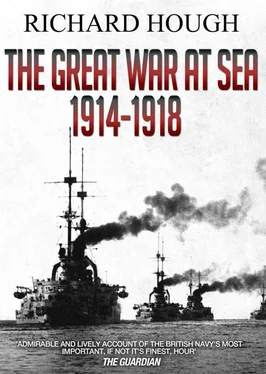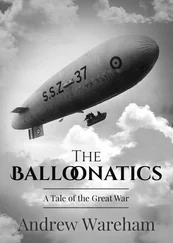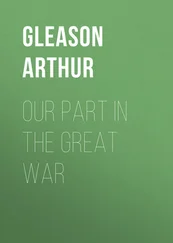In spite of tepid official encouragement and the limited resources available, by the end of 1917 Beatty had wrested control of the air over the North Sea from the Germans. One of the objections put forward against the early carriers was that they were too slow to keep up with the Fleet. In January 1917 Beatty set up the Grand Fleet Aircraft Committee to work on this problem before really fast carriers could be made available. One of the successful solutions was to construct platforms over the conning tower and forward gun of light cruisers. These were a mere 20 feet long, but this was quite enough to get a Sopwith ‘Pup’ fighter airborne with the ship steaming into wind. When the first of these platforms was used operationally in August 1917, Flight Sub-Lieutenant B. A. Smart made history by taking off when a Zeppelin was sighted and shooting the huge craft down in flames, subsequently ditching his ‘Pup’ in the sea.
An alternative to the ship’s platform was a lighter fitted with a 30-foot flight deck and towed at high speed by a destroyer. On 31 July 1918, Flight Lieutenant S. D. Culley took off in a Sopwith ‘Camel’ and shot down the Zeppelin L - 53 . By this time most battle-cruisers and light cruisers had been fitted with fixed or turntable platforms so that quite a swarm of reconnaissance as well as fighter aircraft could be launched. Now the sky as well as the sea was dominated by the British Fleet, in spite of the opposition of numerous gunnery officers and encrusted old salts, the senior admirals with ‘solid ivory from the jaws up, except for a little hole from ear to ear to let useful knowledge go in and out’.
Beatty’s most important contribution to the successful pursuit of the Great War at sea was his sustaining of the optimism and spirit of the Grand Fleet from June 1916 until the end, during which time his own popularity among the officers and men never wavered. ‘The outstanding characteristic of British Sea Power’, wrote one American officer, ‘was its extraordinarily high morale in the face of great handicaps.’ (24)Beatty himself never gave up hope that a second opportunity of meeting the enemy in strength might occur. Like many of his captains and squadron commanders, Beatty found the awful winter weather and boredom of life at Seapa Flow and Rosyth a great burden. There was additionally the sense of helplessness when the Army continued to fight and suffer so heavily. ‘It frets me terribly that with all this terrible fighting going on that we cannot help’, (25)Beatty once wrote in anguish to his wife.
On 21 March 1918 the German Army attacked the British front on the Somme in great strength. A dense fog, far thicker than the North Sea mist which had assisted the German Fleet at Jutland, concealed the German attack until it was too late. The Germans advanced deep into British – and French-held positions, deeper than at any time since 1914. In the throes of this crisis, Marshal Ferdinand Foch took overall command. The Allied armies were forced at last into a war of movement, and the farther they fell back the more disadvantaged were the Germans. Moreover, like the British battle-cruisers at Jutland – ‘the many-headed hydra’ – there seemed to be no end to the Allied reserves. By the end of April the German attack had run out of steam. Supplies could not be sustained; nor could the spirit of the men. Germany knew she was beaten in spite of victory against Russia earlier in the year. Food was becoming desperately short and certain factions were fermenting revolution.
Unrest in the High Seas Fleet was sharpened by well-founded rumours that they were to participate in some sort of ‘death ride’. What had the C.-in-C. in store for them at the end of October, when all seemed lost on land and an armistice could not be long delayed? ‘It is impossible for the Fleet to remain inactive in any final battle that may sooner or later precede an Armistice’, Scheer declared. ‘The Fleet must be committed. Even if it is not to be expected that this would decisively influence the course of events, it is still, from the moral point of view, a question of the honour and existence of the Navy to have done its utmost in the last battle.’ (26)
When the Fleet was ordered to assemble in Schillig Roads outside Wilhelmshaven on 29 October 1918, mutiny broke out in varying degrees, from insubordination and refusal to report for duty to threats of violence. Cheers for peace were heard throughout the Fleet, and even cheers for the American President, Woodrow Wilson. By 4 November, the red flag of revolution was flying at all the German naval ports.
After some inter-service and inter-Allied altercation, the naval terms for an armistice were agreed. ‘The war of exhaustion’, as Scheer described it, was heading for ‘Germany’s certain defeat.’ To be surrendered for internment in neutral ports – or failing them, Allied ports – were 160 submarines, 10 battleships, 6 battle-cruisers and a proportionate number of cruisers and destroyers.
So neglected were the ships of the High Seas Fleet, that it was difficult to get even this reduced force to sea. But at last they did, and Beatty, denied a second Trafalgar, reached the summit of his life and his achievement when he sailed to meet them and take the surrender on 21 November 1918, just ten days after the armies had ceased fighting, with 370 ships and 90,000 officers and men under his command.
Like 31 May 1916, the date on which the Fleets had last met, the weather was sunny but misty. The filthy, neglected condition of the German ships, the scruffy, ill-disciplined state of the German crews on deck, told their own story of what had happened during the previous thirty months to one of the toughest, most professional and skilful fighting forces in the world. Here, forty miles cast of May Island off the entrance to the Firth of Forth, was the tangible proof of British naval omnipotence, and the meaninglessness of Jutland’s pluses and minuses in ship losses.
By 11 a.m. the two Fleets were safely inside the Firth of Forth, where Beatty made a general signal: ‘The German flag will be hauled down at sunset today, Thursday, and will not be hoisted again without permission.’ The German ensigns were duly hauled down as all hands in the flagship Queen Elizabeth were piped aft. On the sounding of the bugle ‘making sunset’, Beatty was given a great round of cheers by the ship’s company and the men of the entire Grand Fleet as well as the American 6th Battle Squadron and the representative French ships.
Beatty answered the cheers With his famous hat held aloft, smiling at the unprecedented scene. ‘I always told you they would have to come out’, he told his men.
Any last pride left to the German Fleet was sunk just seven months later in the biggest act of self-immolation in naval history. On 21 June 1919, in a well-kept conspiracy, the High Seas Fleet scuttled itself in Scapa Flow. The spectacle could also be interpreted as a symbolic act of genuflection at the scene of Britain’s power-base during those years of blockade which had brought about the enemy’s downfall.
The victory of 21 November 1918 was a bloodless and silent one. But it was none the less the greatest naval victory in history, brought about by the sustainment of spirit and distantly and continuously applied superiority in a battle lasting 1571 days and nights. From time to time during this long-drawn-out conflict the two protagonists had brushed up against one another, exchanged fire, suffered and caused losses. Sometimes the engagements had occurred for all to see, as at the Falklands, at other times in the dim visibility of sunset as at Coronel and Jutland, and more often blindly and beneath the ocean. But whether the Grand Fleet was lying at its anchorage at Scapa Flow or engaging enemy destroyers in a tumult of fire and North Sea darkness early on 1 June 1916, the application of superiority remained unchanged. The date 21 November 1918 was important only because it was the day Germany finally resigned herself to the state of affairs which had applied since 11 p.m. on 4 August 1914.
Читать дальше












